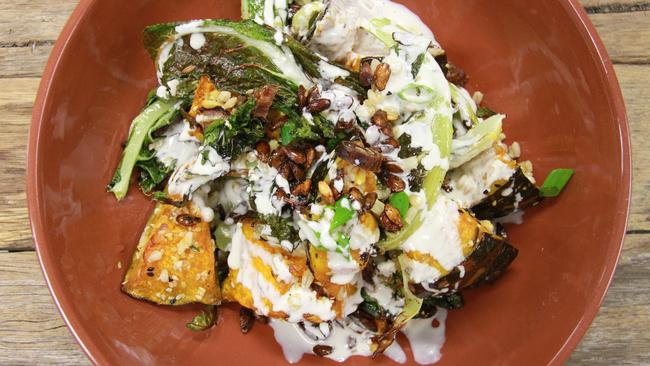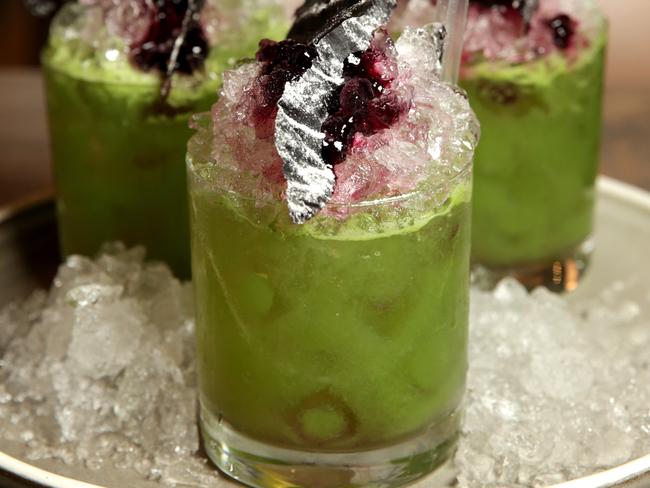Bone broth, trash-to-table dining and wellness wines: food trends to watch
Healthy cocktail matching, ‘bone broth’ (meat stock) and the anti-food-waste movement - culinary trends for 2016.

The world of food and drink has gone topsy-turvy this year: old is new, trash is tasty and health has gone hedonistic. We will bid goodbye to the booze-fuelled happy hour and say hello to wellness wines (and other alcoholic drinks) — bottled, paradoxically, in dark, even eerie packaging designed to conjure the image of a dangerous concoction. Bone broth will go mainstream and fast food will continue to reinvent itself as a quality offer for health-aware millennials.
Forget FebFast — one of the biggest trends this year is drinking more mindfully rather than abstaining altogether. Rather than going on the wagon (widely viewed as too drastic) UK-based the Future Laboratory is predicting drinkers will choose healthier booze options.
“People now want to have a good time without sidestepping alcohol,” says the Laboratory’s co-founder, Martin Raymond. So savvy bartenders are providing curative drinks with fewer morning-after regrets.
At Tonic & Remedy, an apothecary-inspired restaurant and bar in London’s Shoreditch, the use of herbal liqueurs to revitalise and rejuvenate is a central theme. “We looked into why historical apothecaries in the Shoreditch parish used herbs, wines and spices, and found that these elements are antioxidant-rich,” bar manager Jeremy Pascal explains. The Patience & Thyme cocktail, for example, is infused with thyme and honey, which promotes antioxidants to help defend and balance the body.
The cocktail renaissance of the past couple of years is showing no signs of slowing down, either. As we have seen an increasingly sophisticated approach to creating drinks, so too are people drinking in a more sophisticated way. The death knell tolls for happy hour. Say goodbye to saccharine two-for-one drinks and jugs of fluorescent pink liquid guaranteed to make you forget the night ahead.
Instead, we’re seeing the growth of establishments that entice people to stay and sip cocktails all night long. “Dinner is a launch pad to the rest of your night,” says Joe McCanta, brand ambassador for vodka brand Grey Goose. “People want great food and great drink in one place. If you go out and drink all these cheap cocktails before dinner, it is quite hard to move past that.”

In Melbourne, cocktail-matching menus are trending at restaurants such as Lume and Tonka.
And those increasingly sophisticated consumer palates will continue to influence the direction of the fast-food sector. High-end chefs are going budget while fast food chains are elevating their offers. The prices may be low (or lower than high-end, at least), but fast-casual food is having a highbrow makeover. Since New York restaurateur Danny Meyer opened burger bar Shake Shack in 2004, chefs have seen the potential of fast food. Now other names in the industry are recognising how they can provide high-quality food on a tight budget.
Michelin-starred chef Daniel Patterson and food truck king Roy Choi have opened their first LocoL in Los Angeles, a fast-food chain serving quality meat cuts with healthy ingredients such as tofu, keeping costs down while maintaining the look and feel of a fast food burger. “No matter how people grew up, if you give them the choice, they will choose delicious food,” says Patterson.
At new Melbourne diner Biggie Smalls, chef Shane Delia’s first venture into the fast-casual market, you can opt for a less traditional kebab made with flaxseed falafel, salad and hummus.
At the reverse end of the market, traditional fast-food brands such as McDonald’s are elevating their offers to appeal to the more discerning consumer. In Sydney, McDonald’s opened the Corner, a cafe that aims to attract the city’s health-minded coffee aficionados. The menu is self-consciously hipster: think quinoa salads, avocado corn fritters and cold drip coffee.
Other food trends for the year ahead are ancient appetites and trash to table. The former sees people re-adopting our ancestral eating habits as a source of health and wellness. And it’s not just the Paleo diet. “We are now being told that the foods our grandparents ate weren’t so bad after all. As a result, people are looking to traditional ideas that have withstood the test of time,” says Jody Vassallo, author of Beautiful Food.
Meat stock, rebranded as “bone broth”, is the most popular of these age-old recipes, with Sydney’s Bone Broth Bar & Larder opening in December last year, offering up frozen broth cubes as well as steaming cups of boiled bones.

Meanwhile, the trash-to-table movement, popularised by Australia’s zero-waste warrior Joost Bakker, is continuing to gain traction as concerns about food waste permeate the national consciousness: last year, food rescue organisation OzHarvest opened pop-up Harvested in Pyrmont, the nation’s first restaurant serving food destined for the landfill.
And the 2016 consumer? Raymond sums up the type: “Savvy, entitled, cares more than ever about provenance and experience but refuses to sacrifice on convenience and price.
“We’ll see tried and tested (business) models topple, replaced by challenger brands who understand these new consumer desires.”
Trends to watch
Trash to table: Move over farm to table — innovative chefs are looking to waste to disrupt the food chain and put it on a plate.
Anti-happy hour: Cocktails are no longer seen as the quickest route to a pleasant buzz but are being reframed as an accompaniment to meals — like a fine wine to be sipped, not downed.
High-low dining: Chefs and restaurant brands are going high-low and back again. High-end chefs are offering low-end dining with quality ingredients, while chains such as Starbucks and Taco Bell are offering higher-end options for the more discerning customer.
Alcohealth: Consumers have health in the back of their minds, even when they are out drinking. It’s the fun of alcohol in a setting of wellness.
Dark arts: An eerie mood is influencing packaging design in the beverage industry, with wines and beers being rebranded as dangerous concoctions.
Wabi sabi: Notions of imperfection dominating Japanese aesthetic tradition are giving rise to packaging that challenges perceptions of beauty with rough and raw, highly tactile surfaces and expressive unpolished marks.
Food + Drink Futures Forum, February 18 at the Lawler Studio, MTC Theatre, 140 Southbank Blvd, Southbank, Melbourne. thefuturelaboratory-au.eventbrite.com

To join the conversation, please log in. Don't have an account? Register
Join the conversation, you are commenting as Logout